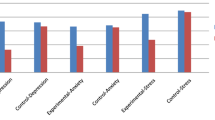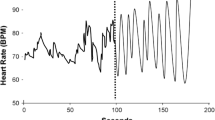Abstract
This study examines the relationship between Spiegel's Hypnotic Induction profile (HIP) and ability to perform EMG relaxation under conditions of self-induced and audio-assisted biofeedback training. One hundred women volunteered for screening with Spiegel's test for hypnotizability. Thirty students were then selected from the top, middle, and bottom of the HIP scoring distribution for EMG biofeedback training in relaxation. Three treatment trials included baseline, EMG biofeedback with self-induced relaxation, and EMG biofeedback with audio relaxation instructions. Contrary to predictions, high HIPs were not significantly different from low HIPs on any of the treatment measures, although all students showed a training effect. The middle HIPs demonstrated significantly higher levels of EMG activity than the extreme groups.
Similar content being viewed by others
Reference Note
Dumas, R. A.Hypnotizability and biofeedback. Paper presented to the Society for Clinical and Experimental Hypnosis, Los Angeles, October 1977.
References
Andreychuk, T., & Skriver, C. Hypnosis and biofeedback in the treatment of migraine headaches.International Journal of Clinical and Experimental Hypnosis 1975,23 172–183.
Barefoot, J. C. Anxiety and volunteering.Psychonomic Science 1969,16 283–284.
Budzynski, T. H. Forehead and facial relaxation. InRelaxation training programs. New York: Bio Monitoring Applications, 1974. (Audiotape)
Engstrom, D. R. Interactional effects of muscle tension and EEG alpha production on hypnotic susceptibility.A.P.A. Proceedings, Honolulu, September 1972.
Friedman, H., & Taub, H. A. A six month follow-up of the case of hypnosis and biofeedback procedures in essential hypertension.American Journal of Clinical Hypnosis 1978,20 184–188.
Nowles, D. P., & Rhead, J. C. Relation of eyes-closed resting EEG alpha to hypnotic susceptibility.Perceptual and Motor Skills 1968,27 1047–1050.
Sarbin, T. R., & Slagle, R. W. Hypnosis and psychophysiological outcomes. In E. Fromm & R. E. Shor (Eds.),Hypnosis: Research developments and perspectives. Chicago: Aldine-Atherton, 1972.
Speigel, H., & Speigel, D.Trance and treatment: Clinical issues of hypnosis. New York: Basic Books, 1978.
Wickramasekera, I. E. Effects of EMG feedback on hypnotic susceptibility.Journal of Abnormal Psychology 1973,82 74–77.
Author information
Authors and Affiliations
Rights and permissions
About this article
Cite this article
Di Scipio, W.J., Weigand, P.A. Hypnotizability and response to EMG relaxation training. Biofeedback and Self-Regulation 6, 493–499 (1981). https://doi.org/10.1007/BF00998734
Issue Date:
DOI: https://doi.org/10.1007/BF00998734




